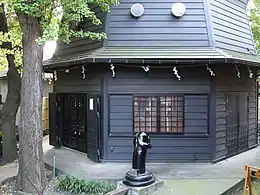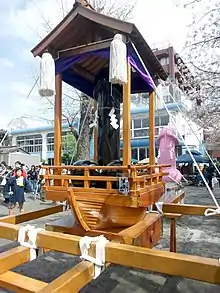Kanamara Matsuri
| Kanamara Matsuri | |
|---|---|
 | |
| Observed by | Kanayama shrine, Kawasaki, Japan |
| Type | Religious |
| Date | First Sunday in April |
| 2022 date | April 3 |
| 2023 date | April 2 |
| 2024 date | April 7 |
| 2025 date | April 6 |
| Frequency | annual |
The Shinto Kanamara Matsuri (かなまら祭り, "Festival of the Steel Phallus") is an annual Japanese festival held each spring at the Kanayama Shrine (金山神社, Kanayama-jinja) in Kawasaki, Japan. The exact dates vary: the main festivities fall on the first Sunday in April. The phallus, as the central theme of the event, is reflected in illustrations, candy, carved vegetables, decorations, and a mikoshi parade.[1][2][3][4][5] The shrine is part of the Wakamiya Hachimangu Shrine[6] and located near Kawasaki-Daishi Station.
The Kanamara Matsuri is centered on the Kanayama Shrine where the god Kanayama-hiko and the goddess Kanayama-hime are venerated. They are both gods of blacksmithing, metalsmithing, and metal works, and are also prayed to for easy childbirth, marital harmony, and protection from sexually transmitted infections.[6][7]
The festival started in 1969.[8] Today, it has become something of a tourist attraction and is used to raise money for HIV research.[9]
Mikoshi
At the Kanamara Festival, three portable shrines, "Kankiiamara Mikoshi," "Kanayama Boat Mikoshi," and "Elizabeth Mikoshi," are patrolled.
- Kanamara Mikoshi
- A portable shrine with a square base and a roof. A wooden phallus is housed inside. The oldest of the three portable shrines.
- Kanamara Boat Mikoshi
- A portable shrine with a boat-shaped base and a roof. Inside, a glowing black iron phallus is housed upwards. It was donated by Hitachi Zosen.
- Elizabeth Mikoshi
- A portable shrine with a huge pink dildo on the base. There is no roof. This portable shrine was donated by the crossdressing club (女装クラブ) "Elizabeth Kaikan" in Asakusabashi. The other two portable shrines are mainly carried by local parishioners, while the bearers are mainly women dressed as Elizabeth Hall, and they are patrolling with a unique shout of "Kanamara!" In 2016 this shrine switched to being displayed on a wheeled trolley.[10] In 2017, the cruising on the road was revived,[11] but it was a one-way trip to Daishi Park, and after being covered with a white cloth in the park, it was pushed back to the shrine.
Gallery
 Kanayama Shrine
Kanayama Shrine Kanamara mikoshi
Kanamara mikoshi Penis (and vulva) candy
Penis (and vulva) candy
See also
- Hōnen Matsuri (Harvest Festival), whose main features include a 2.5 meter-long wooden phallus
- Phallic processions
- Tyrnavos, a city in Greece that holds an annual phallus festival
- Ōkunitama Shrine (friendship shrine)
References
- "Dammit, we missed The Festival of the Steel Phallus in Japan this weekend - Cosmopolitan". cosmopolitan.co.uk. Archived from the original on 2014-04-13. Retrieved 2014-04-11.
- Dominique Mosbergen (7 April 2014). "Japan's Annual Penis Festival Is As Phallic As You'd Expect (PHOTOS)". huffingtonpost.com. Retrieved 2014-04-11.
- Times LIVE. "Japanese festival celebrates the penis - Times LIVE". timeslive.co.za. Retrieved 2014-04-11.
- "The World Today Archive - Japan's Festival of the Steel Phallus". abc.net.au. 2001-04-02. Retrieved 2014-04-11.
- "BBC - Travel - Slideshow - Ten events not to miss in April". Archived from the original on 2014-03-31. Retrieved 2014-04-11.
- "神奈川県神社庁/神社検索/若宮八幡宮". www.kanagawa-jinja.or.jp. Retrieved 2021-06-24.
- "金山神社". jinjajin.jp. Retrieved 2021-06-23.
- 世界も驚くニッポン旅行100: テーマでめぐる!47都道府県ローカル旅 PHP研究所, Jul 4, 2013
- "Kanamara-Matsuri | World's weirdest festivals". Herald Sun.
- 黒木貴啓 (2016-04-07). "客の露出行為で男根型モニュメントを自粛した奇祭「かなまら祭」 2016年度の改善に見る、神事存続への想い". ねとらぼ. Retrieved 2020-02-28.
- 和才雄一郎 (2017-04-02). "【かなまら祭り2017レポート】今年の「男根みこし」は上下左右ムーブあり! 昨年より壮観さがアップして大盛況 / 動画&画像あり". ROCKET NEWS 24. Retrieved 2020-02-28.